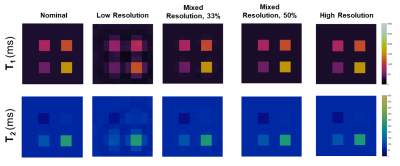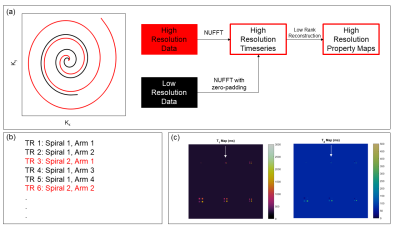Kathleen Ropella-Panagis1, Jesse Hamilton1, and Nicole Seiberlich1
1Department of Radiology, University of Michigan, Ann Arbor, MI, United States
1Department of Radiology, University of Michigan, Ann Arbor, MI, United States
A data
sampling scheme of interleaved high- and low-resolution spiral trajectories for
MR Fingerprinting is proposed to reduce the acquisition time needed to collect high-resolution
tissue property maps.

Fig 3: Multi-resolution
MRF results in the 2x2 pixel squares of the resolution phantom.
The first column shows the ground truth T1 and T2 maps. The second column shows
the result of acquiring low-resolution data and simply zero-padding the images;
significant blurring is evident. The third column shows the result of acquiring
33% of the data with the high-resolution spiral trajectory. The fourth column shows
the result of acquiring 50% of the data with the high-resolution spiral
trajectory. The fourth column shows the result of acquiring all data with the high-resolution
spiral.

Fig 1:(a)
Flowchart for the proposed method. High-resolution data (red) and low-resolution
data (black) are acquired and reconstructed to generate high-resolution
timeseries images. A low rank reconstruction method is used to obtain property
maps. (b) Spiral sampling scheme for 33% high-resolution data, where spiral 1
is the low-resolution spiral and spiral 2 is the high-resolution spiral. (c)
Resolution phantom. Each cluster includes 4
squares with different T1 and T2 values, and range in size from 1x1 to
6x6 pixels. The white arrow denotes the 2x2 pixel cluster used in
Figs 2-3.